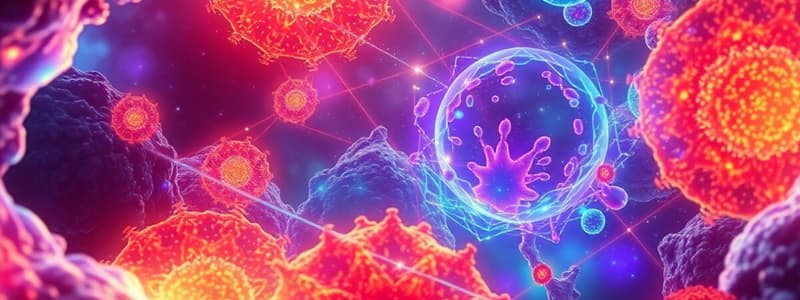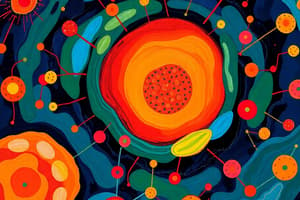Podcast
Questions and Answers
Match the following terms with their definitions:
Match the following terms with their definitions:
Cell membrane = Regulates movement of chemicals DNA = Genetic material in cells Microscope = Tool for observing small structures Cork = Material from which first cells were observed
Match the following cell features with their groups:
Match the following cell features with their groups:
Prokaryotic cells = Bacteria and archaea Eukaryotic cells = Plants and animals Cytoplasm = Site of DNA in prokaryotes Nucleus = Subcellular compartment in eukaryotes
What is fundamental unit of life ?
What is fundamental unit of life ?
- Atoms
- Cells (correct)
- Molecules
- Organelles
Which type of cells lack intracellular membranes and have their DNA located in the cytoplasm?
Which type of cells lack intracellular membranes and have their DNA located in the cytoplasm?
Who formally articulated the cell theory in 1839?
Who formally articulated the cell theory in 1839?
What was Robert Hooke actually observing when he first discovered cells in 1665?
What was Robert Hooke actually observing when he first discovered cells in 1665?
In what compartment is DNA stored within eukaryotic cells?
In what compartment is DNA stored within eukaryotic cells?
Which of the following statements is true regarding red blood cells?
Which of the following statements is true regarding red blood cells?
What does the cell membrane primarily regulate?
What does the cell membrane primarily regulate?
What significant concept predates Darwin's theory of evolution?
What significant concept predates Darwin's theory of evolution?
What significant contribution to cell biology did Anton van Leeuwenhoek make in 1674?
What significant contribution to cell biology did Anton van Leeuwenhoek make in 1674?
Which scientist formalized the concept that all cells arise from pre-existing cells?
Which scientist formalized the concept that all cells arise from pre-existing cells?
Which invention was crucial to the enhanced study of cellular structures in the 20th century?
Which invention was crucial to the enhanced study of cellular structures in the 20th century?
What was one of the key findings by N. Pringsheim concerning cell reproduction?
What was one of the key findings by N. Pringsheim concerning cell reproduction?
All cells contain DNA.
All cells contain DNA.
Match the following scientists with their contributions to cell biology:
Match the following scientists with their contributions to cell biology:
Which type of cell has its DNA stored in the nucleus?
Which type of cell has its DNA stored in the nucleus?
Who was the first person to observe live cells under a microscope?
Who was the first person to observe live cells under a microscope?
The first continuous human cell line was established in 1951 from cervical cancer cells.
The first continuous human cell line was established in 1951 from cervical cancer cells.
Which scientist is credited with the discovery of the cell nucleus?
Which scientist is credited with the discovery of the cell nucleus?
The term 'Omnis cellula e cellula' translates to 'All cells come from pre-existing cells.'
The term 'Omnis cellula e cellula' translates to 'All cells come from pre-existing cells.'
Which technological advancement was crucial for the study of cellular structures in the 20th century?
Which technological advancement was crucial for the study of cellular structures in the 20th century?
Flashcards
Cell Theory's First Two Tenets
Cell Theory's First Two Tenets
All living things are composed of cells, and cells are the basic units of structure and function in living things.
Omnis cellula e cellula
Omnis cellula e cellula
All cells only arise from pre-existing cells
HeLa Cells
HeLa Cells
A continuous human cell line derived from cervical cancer cells of Henrietta Lacks.
Cell Biology
Cell Biology
Signup and view all the flashcards
Compound Microscope
Compound Microscope
Signup and view all the flashcards
Anton van Leeuwenhoek
Anton van Leeuwenhoek
Signup and view all the flashcards
Cell Nucleus
Cell Nucleus
Signup and view all the flashcards
Cell
Cell
Signup and view all the flashcards
Cell theory
Cell theory
Signup and view all the flashcards
Robert Hooke
Robert Hooke
Signup and view all the flashcards
Cell membrane
Cell membrane
Signup and view all the flashcards
Prokaryotic cell
Prokaryotic cell
Signup and view all the flashcards
Eukaryotic cell
Eukaryotic cell
Signup and view all the flashcards
Light microscope
Light microscope
Signup and view all the flashcards
Cell specialization
Cell specialization
Signup and view all the flashcards
Cell Theory's Third Tenet (Original)
Cell Theory's Third Tenet (Original)
Signup and view all the flashcards
Virchow's Dictum
Virchow's Dictum
Signup and view all the flashcards
Cell Culture
Cell Culture
Signup and view all the flashcards
Transfection
Transfection
Signup and view all the flashcards
Green Fluorescent Protein (GFP)
Green Fluorescent Protein (GFP)
Signup and view all the flashcards
Small Interfering RNA (siRNA)
Small Interfering RNA (siRNA)
Signup and view all the flashcards
Cell Doctrine
Cell Doctrine
Signup and view all the flashcards
Cell Theory Proponents
Cell Theory Proponents
Signup and view all the flashcards
What did Hooke see?
What did Hooke see?
Signup and view all the flashcards
Micrographia
Micrographia
Signup and view all the flashcards
Cell Membrane Function
Cell Membrane Function
Signup and view all the flashcards
DNA Location in Prokaryotes
DNA Location in Prokaryotes
Signup and view all the flashcards
Eukaryotic Cell DNA Storage
Eukaryotic Cell DNA Storage
Signup and view all the flashcards
Who discovered cells?
Who discovered cells?
Signup and view all the flashcards
Original Cell Theory
Original Cell Theory
Signup and view all the flashcards
Who observed live cells first?
Who observed live cells first?
Signup and view all the flashcards
What did Hooke observe?
What did Hooke observe?
Signup and view all the flashcards
Schleiden and Schwann's contribution
Schleiden and Schwann's contribution
Signup and view all the flashcards
What is 'Omnis cellula e cellula'?
What is 'Omnis cellula e cellula'?
Signup and view all the flashcards
GFP
GFP
Signup and view all the flashcards
siRNA
siRNA
Signup and view all the flashcards
What are organoids?
What are organoids?
Signup and view all the flashcards
CRISPR
CRISPR
Signup and view all the flashcards
Study Notes
Cell Biology History
- Single cells are the fundamental unit of life, existing as unicellular or forming multicellular organisms.
- Cells vary, from prokaryotic (bacteria, archaea) to eukaryotic (plants, animals). Sub-types also exist (red blood cells, neurons, epithelial cells).
- Cell membranes define cells, regulating chemical movement in and out.
- Most cells contain DNA, stored in a nucleus (eukaryotes) or cytoplasm (prokaryotes).
- Mature red blood cells lack DNA.
Cell Theory
- All organisms are composed of cells (cell theory).
- Schleiden and Schwann articulated the cell theory in 1839.
- The cell theory predates key biological paradigms (evolution, inheritance, comparative biochemistry).
- The cell theory's first two tenets are accurate; the third is flawed (cell division, described later as “Omnis cellula e cellula”).
Early Cell Discoveries
- Robert Hooke first described "cells" in 1665 (cork cells; dead plant cells).
- Anton van Leeuwenhoek observed live cells (algae, possibly bacteria) in 1674.
- The cell nucleus was observed in 1833.
- Schwann & Schleiden proposed the cell theory in 1838.
- The idea that cells only come from preexisting cells was formalized by Virchow's "Omnis cellula e cellula".
Modern Cell Biology
- Mid-20th century saw an explosion of cell biology research, including cell culture techniques.
- HeLa cells (cancer cells from Henrietta Lacks) were a pivotal achievement in cell study.
- Developments in electron microscopy, transfection, GFP, siRNA expanded knowledge.
- Cell biology is a rapidly advancing area.
- Advances in microscopes and reagents continue to enhance understanding, especially in clinical settings.
Cell Biology Timeline Highlights
- 1595: First compound microscope invented.
- 1655: Hooke describes cells in cork.
- 1674: Leeuwenhoek discovers protozoa (and possibly bacteria).
- 1833: Brown describes cell nucleus.
- 1838: Schleiden & Schwann propose cell theory.
- 1840: Sperm and egg cells identified as cells.
- 1856-58: Observation of fertilization and Virchow’s Omnis cellula e cellula.
- 1857: Mitochondria described.
- 1879: Chromosome behavior during mitosis described.
- 1883: Germ cells are haploid.
- 1898: Golgi apparatus described.
- 1938: Nuclei separation technique.
- 1939: Commercial transmission electron microscope.
- 1951: Continuous human cell line (HeLa cells).
- 1955: Animal cell nutritional needs defined.
- 1957: Nucleic acid separation technique.
- 1965-76: Serum-free media, scanning electron microscopy, and more cell line innovations.
- 1981-2006: Transgenic organisms, stem cell lines, and induced pluripotent stem cells (iPSCs).
- 1995: Enhanced GFP mutant.
- 1998: Cloning from somatic cells.
- 1999: siRNA discovery.
- 2009: Single-cell sequencing and organoid research.
- 2012: CRISPR gene editing.
Studying That Suits You
Use AI to generate personalized quizzes and flashcards to suit your learning preferences.




